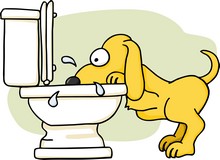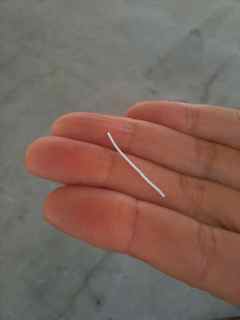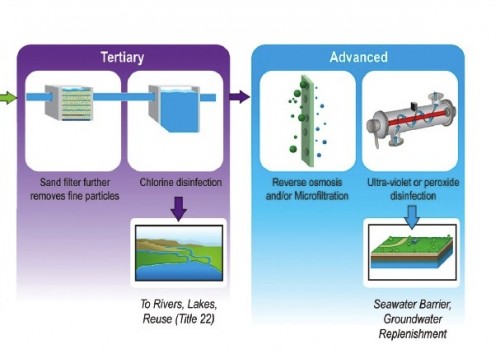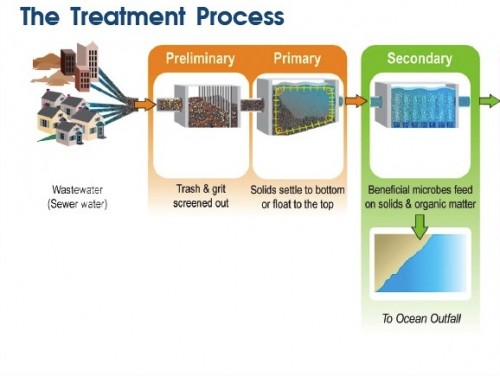L.A. tries some new technology to get past the “yuck factor”
Hear the companion radio feature to this post on The California Report.

For the record: the route isn’t nearly as direct as the popular canine version. I tasted this water in Orange County and it’s fine — actually, a little “tasteless” since all the minerals had been removed from it as well. The engineering folks in both Orange County and LA’s Department of Water and Power will tell you that this recycled water has a “distilled” quality to it.
With the future of Southern California’s water supply in some doubt, municipal water managers are moving again toward the ultimate recycling strategy, which lingers in the public’s mind with such appetizing monikers as “toilet to tap.” The region went through a political tempest a decade ago as it tried to bring the East Valley Water Recycling Project on line, a system that did not use the final “advanced” stage of water treatment (being used today in the OC and proposed for the new effort by LADWP). Mired in engineering concerns and a public relations mess, the project was scuttled by newly-elected LA mayor James Hahn. Today, the technology has improved and now, the process has a successful SoCal track record for “potable re-use.”
The process is lengthy but pretty easy to understand. Here are the details, courtesy of the City of Los Angeles Department of Water and Power and Orange County’s Groundwater Replenishing System:
• First, the wastewater goes through a preliminary stage where all the trash and grit is screened out. Then comes the primary stage where “solids” (I think you know what I’m talkin’ about) either settle to bottom or float to the top: those are removed.
• At the secondary stage, microbes are added: those wonderful little creatures that actually feed on the organic matter, nature’s original recyclers.

• A sand filter stage starts the tertiary process, and removes finer particles. Then can come a chlorine disinfection after which — very important — the chlorine is then extracted. What you’re left with is tertiary water, which meets state health department standards for purposes such as freeway landscaping, artificial snow — even safe enough for food crops. At this writing, “no health-related problems have been traced to any of the water recycling projects currently operating in California,” according to DWP.
This tertiary water keeps the Japanese Garden next to the L.A. Bureau of Sanitation’s Tillman plant in Van Nuys lush and green. It also provides water to recharge the Los Angeles River. Even the air conditioning at the Tillman facility is run on the plant’s tertiary water.

The final stage, the “advanced” process, sends the tertiary water through two final cleaning mechanisms. The first is reverse osmosis and/or microfiltration. At this point, the water at the Orange County plant smelled pretty fresh, almost like a saltwater “seaside” smell. Microfiltration sends the already-treated water through hollow polypro fibers — think straws with tiny holes: bacteria and a good number of viruses are removed. Then comes reverse osmosis, in which the water is forced through thin filtering membranes at high pressure. This removes dissolved chemicals, pharmaceuticals and even more viruses.
The ultimate stages include zapping the water with untraviolet light and a peroxide disinfection. This stage removes dangerous trace organic compounds like N-nitrosodimethylamine (NDMA) and 1,4-dioxane. NDMA is a by-product of rocket fuel manufacturing, and 1,4 dioxane is a stabilizer used in industrial solvents. DWP has broken ground on a stand-alone UV filtering plant in Sylmar, north of downtown LA, as KPCC Radio reporter Molly Peterson reported earlier this year. A side benefit of UV cleaning means that water engineers can use fewer chemicals to get the job done. UV is also an effective low-tech method: just ask the residents of Nairobi, Kenya’s Kibera district.
At the end of the advanced treatment phase, the water is pure enough to drink, and pure enough to be pumped back into your local water district’s reservoirs or groundwater basins, where it blends with the natural groundwater supply, waiting for its next journey to your tap.

UPDATE: We’ve edited this post to correctly identify ownership of the Tillman treatment plant in Van Nuys.
13 thoughts on “Another Run for Flush-to-Faucet Water Recycling”
Comments are closed.


The Tillman plant is operated by the Los Angeles Bureau of Sanitation — not Los Angeles Department of Water and Power.
JP, thank you for the correction. My error. // Kimberly Ayers, correspondent
If San Francisco were to replicate the sustainable water practices of OC & LA it could reduce its use of Tuolumne River water and restore the Hetch Hetchy Valley in Yosemite. I’d urge you to do a story comparing “green” SF to “water wasting” LA.
While commercially-manufactured NDMA can be present in contaminated groundwater as a leftover from the process of “rocket fuel manufacturing,” it is unlikely to find wastewater NDMA occurring from such a source. NDMA also is not likely to be sourced to specific products used in water treatment. As can be read at http://grac.org/Wong_NDMA.PDF “Laboratory studies demonstrated that this compound was formed by conventional drinking water treatment processes and was not a contaminant associated with the treatment chemicals.”
The UV light breaks apart the type of NDMA that likely would be present in wastewater treatment processing. While there is NDMA contamination on some Department of Defense properties, a different type of NDMA is formed during the wastewater treatment processes and drinking water purification processes. This NDMA is not sourced to the separate product that was created for military purposes and released to the earth during weapons manufacture. NDMA also is created during the manufacture of solvents, rubbers and smoked food, as can be read at http://www.environmental-expert.com/Files/11087/articles/5665/uv_04_36.pdf.
Does NDMA need to be tracked in drinking water? Yes. Does the US military need to take responsibility to clean up military-caused NDMA contamination in groundwater? Yes. Do we unreasonably want people to believe home tap drinking water is contaminated with military rocket fuel products when drinking water trackable NDMA is created via completely separate processes that have nothing to do with groundwater contamination? In the absence of supporting evidence to link these two issues, no.
Supplement:
The Environmental Protection Agency publishes a fact sheet on NDMA at http://www.epa.gov/fedfac/documents/emerging_contaminant_ndma.pdf.
The EPA fact sheet describes NDMA for purposes of this article as “an unintended byproduct of the chlorination of wastewater and drinking water at treatment plants that use chloramines for disinfection.”
Even tertiary treatment (consisting of primary sedimentation, trickling filter/activated sludge, disinfection, coagulation, direct filtration, and chlorination) does not remove all pathogens. There are several ways in which an individual can acquire disease from wastewater use. Direct ingestion of the wastewater or aerosols created during spray irrigation may result in infection. In addition, infection may occur from ingestion of pathogens on contaminated vegetation or other surfaces. Another potential route of exposure is from the ingestion of ground water that has been contaminated by pathogens in irrigation water. Indeed, viruses have been detected in ground water located 27.5m below a site irrigating crops with reclaimed water. The research is clear on these points and yet the wastewater industry pushes the public to be exposed to this hazard?
Note to JP;
the pipe line to carry the reclaimed water is installed and maintained by The Department of Water and power
A PERFECT STORM OF ANTIBIOTIC RESISTANCE
http://thewatchers.us/myths/number-4-antibiotics.html
When the wastewater industry tells you what a coliform is will be the day you might be able to have some confidence in the programs they push. Seven of the coliforms are on the Department of Health and Human Service list of dangerous bioterrorism biological agents. Seven out of the forty-eight bacterial families of biological agents on the complete list are normal and thermotolerant coliforms. Another twenty-three coliforms meet the definition of a dangerous biological agent. The seven coliforms and fecal coliforms families on the biological agent list are: Edwardsiella tarda; Escherichia coli, all enteropathogenic serotypes; Klebsiella – all species and all serotypes; Proteus – all species; Salmonella – all species and all serotypes; Shigella – all species and all serotypes; and Yersinia (Pasteurella) pestis,Y. Enterocolitica.
California specifically allows these coliforms in reclaimed water. Not only that, but EPA allows the drinking water treatment plants to fail 5% of the required monthly tests.
All water was once wastewater. Vast volumes of strawberries and artichokes grown in the central valley are irrigated with recycled wastewater, which tests cleaner than the groundwater that used to irrigate them. Yet we don’t see any major protest of this use. Water that is cleaned and disinfected with UV, etc., can be cleaner than ground and surface water sources. At the same time, bacteria can grow in our intake pipes to our homes, which is why drinking water is mandated to have a chlorine (or similar) residual.
A little research is in order. “Since 1995, the Salinas Valley has been connected to nine of the 20 outbreaks of E. coli O157:H7 associated with lettuce and spinach.
The episode left the Salinas Valley with a tarnished reputation, a $77 million loss to its spinach crop and a marked drop in bagged salad sales, which were down $10.5 million, according to the 2006 Monterey County Crop Report released last week.(Dawn Withers, 2007)”
http://thewatchers.us/water_reuse.html
“Approximately 20+ million gallons a day of reclaimed sewage effluent water is used to irrigate lettuce, celery, broccoli, cauliflower, artichokes, and strawberries
on 12,000 acres of California’s “salad bowl” in Salinas Valley, California. The reclaimed sewage effluent water is distributed to 222 parcels of farmland through 46 miles of pipes, 8 inches to 51 inches in diameter. Only a simple coliform test is required after the sewage water is disinfected with chlorine. Chlorine temporarily
causes bacteria to go dormant and amplifies antibiotic resistance of bacteria released for irrigation. Surviving bacteria multiply during the 46 mile trip through
the pipeline as well as attaching to the pipe walls in biofilms. As the biofilms mature, or the pipes are disturbed, they slough off with the potential to contaminate the vegetables in isolate spots.” http://thewatchers.us/book/wrong-focus-scientist.html
The “toilet-to-tap” moniker is a bit unsettling but considering the water shortage in southern California it may be necessary step to solve the water problems. I hope this technology spreads and continues to improve.
This is a great conversation going on here, thank you all.
I apologize for the delayed posting of some comments. That tends to happen with comments that contain URLs. It’s a way that our software protects us against spam. Comments with URLs require direct intervention by an editor to approve them and that takes a little longer. Please don’t let it stop you from providing us with links to useful information.
Craig Miller
Sr. Editor, Climate Watch